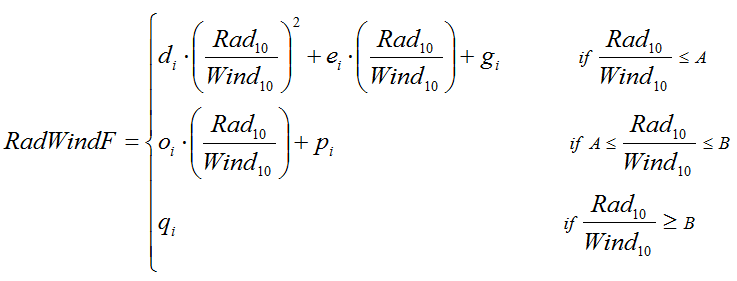This model calculates the amylose content of rice kernels as a function of average temperature experienced by the crop during the whole ripening period. The amylose estimation is then corrected by an adimensional factor which account for the effect of average global solar radiation and wind speed perceived by the crop during the first ten days after flowering.
The general equations for Indica and Japonica ecotypes are given below:

Where:
AC (%) is the amylose content of rice kernel as percentage of grain dry weight (D.W.);
Tavg (°C) is the average air temperature within the whole ripening period;
RadWindF (MJ s m-4 d-1) is a factor triggering the AC variations due to the impact of solar radiation and wind during the first ten days of ripening;
ai (0.1384 for Loto, 0.1693 for Gladio; unitless), bi (- 6.1338 for Loto, -7.0109 for Gladio; unitless), ci (83.9114 for Loto, 97.0356 for Gladio; unitless), are coefficients of the equation, specific for Japonica and Indica varieties.
The RadWindF is calculated using the following equation:

Where:
Rad10 (MJ m-2 d-1) is the average global solar radiation experienced by the rice crop during the first ten days of ripening;
Wind10 (m2 s-1) is the average wind speed experienced by the rice crop during the first ten days of ripening;
di (0 for Loto, 0.0007 for Gladio; unitless), ei (-0.0607 for Loto, -0.198 for Gladio; unitless), gi (2.5 for Loto, 1.9363 for Gladio; unitless), oi (-2.0093 for Loto, -0.0328 for Gladio; unitless), pi (40.302 for Loto, -1.1819 for Gladio; unitless), qi (-2.5005 for Loto and Gladio; unitless), are coefficients of the equation, specific for Japonica and Indica varieties;
A (19.4 for Loto, 20.7 for Gladio), B (40.2 for both varieties), (m2 s-1) are thresholds triggering the points of discontinuity of the RadWindF function.
Created with the Personal Edition of HelpNDoc: Easy CHM and documentation editor